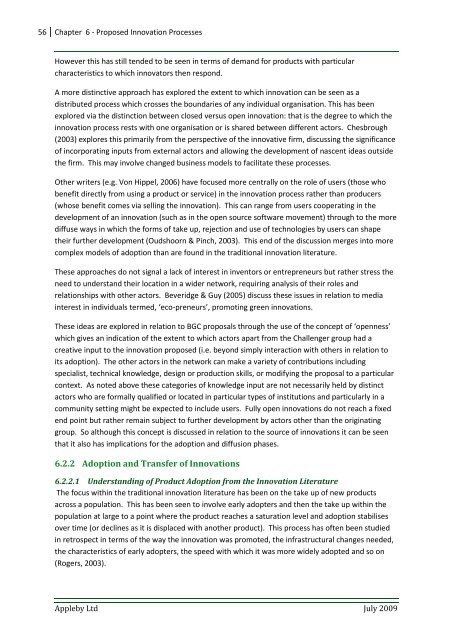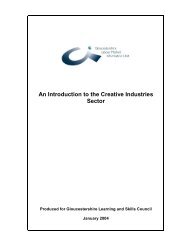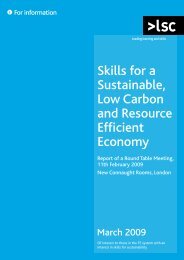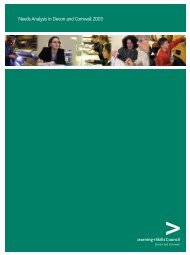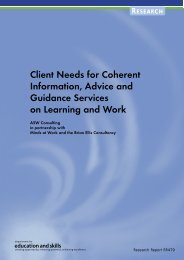Mapping the Big Green Challenge - The Skills & Learning ...
Mapping the Big Green Challenge - The Skills & Learning ...
Mapping the Big Green Challenge - The Skills & Learning ...
You also want an ePaper? Increase the reach of your titles
YUMPU automatically turns print PDFs into web optimized ePapers that Google loves.
56 Chapter 6 - Proposed Innovation ProcessesHowever this has still tended to be seen in terms of demand for products with particularcharacteristics to which innovators <strong>the</strong>n respond.A more distinctive approach has explored <strong>the</strong> extent to which innovation can be seen as adistributed process which crosses <strong>the</strong> boundaries of any individual organisation. This has beenexplored via <strong>the</strong> distinction between closed versus open innovation: that is <strong>the</strong> degree to which <strong>the</strong>innovation process rests with one organisation or is shared between different actors. Chesbrough(2003) explores this primarily from <strong>the</strong> perspective of <strong>the</strong> innovative firm, discussing <strong>the</strong> significanceof incorporating inputs from external actors and allowing <strong>the</strong> development of nascent ideas outside<strong>the</strong> firm. This may involve changed business models to facilitate <strong>the</strong>se processes.O<strong>the</strong>r writers (e.g. Von Hippel, 2006) have focused more centrally on <strong>the</strong> role of users (those whobenefit directly from using a product or service) in <strong>the</strong> innovation process ra<strong>the</strong>r than producers(whose benefit comes via selling <strong>the</strong> innovation). This can range from users cooperating in <strong>the</strong>development of an innovation (such as in <strong>the</strong> open source software movement) through to <strong>the</strong> morediffuse ways in which <strong>the</strong> forms of take up, rejection and use of technologies by users can shape<strong>the</strong>ir fur<strong>the</strong>r development (Oudshoorn & Pinch, 2003). This end of <strong>the</strong> discussion merges into morecomplex models of adoption than are found in <strong>the</strong> traditional innovation literature.<strong>The</strong>se approaches do not signal a lack of interest in inventors or entrepreneurs but ra<strong>the</strong>r stress <strong>the</strong>need to understand <strong>the</strong>ir location in a wider network, requiring analysis of <strong>the</strong>ir roles andrelationships with o<strong>the</strong>r actors. Beveridge & Guy (2005) discuss <strong>the</strong>se issues in relation to mediainterest in individuals termed, ‘eco-preneurs’, promoting green innovations.<strong>The</strong>se ideas are explored in relation to BGC proposals through <strong>the</strong> use of <strong>the</strong> concept of ‘openness’which gives an indication of <strong>the</strong> extent to which actors apart from <strong>the</strong> <strong>Challenge</strong>r group had acreative input to <strong>the</strong> innovation proposed (i.e. beyond simply interaction with o<strong>the</strong>rs in relation toits adoption). <strong>The</strong> o<strong>the</strong>r actors in <strong>the</strong> network can make a variety of contributions includingspecialist, technical knowledge, design or production skills, or modifying <strong>the</strong> proposal to a particularcontext. As noted above <strong>the</strong>se categories of knowledge input are not necessarily held by distinctactors who are formally qualified or located in particular types of institutions and particularly in acommunity setting might be expected to include users. Fully open innovations do not reach a fixedend point but ra<strong>the</strong>r remain subject to fur<strong>the</strong>r development by actors o<strong>the</strong>r than <strong>the</strong> originatinggroup. So although this concept is discussed in relation to <strong>the</strong> source of innovations it can be seenthat it also has implications for <strong>the</strong> adoption and diffusion phases.6.2.2 Adoption and Transfer of Innovations6.2.2.1 Understanding of Product Adoption from <strong>the</strong> Innovation Literature<strong>The</strong> focus within <strong>the</strong> traditional innovation literature has been on <strong>the</strong> take up of new productsacross a population. This has been seen to involve early adopters and <strong>the</strong>n <strong>the</strong> take up within <strong>the</strong>population at large to a point where <strong>the</strong> product reaches a saturation level and adoption stabilisesover time (or declines as it is displaced with ano<strong>the</strong>r product). This process has often been studiedin retrospect in terms of <strong>the</strong> way <strong>the</strong> innovation was promoted, <strong>the</strong> infrastructural changes needed,<strong>the</strong> characteristics of early adopters, <strong>the</strong> speed with which it was more widely adopted and so on(Rogers, 2003).Appleby Ltd July 2009


